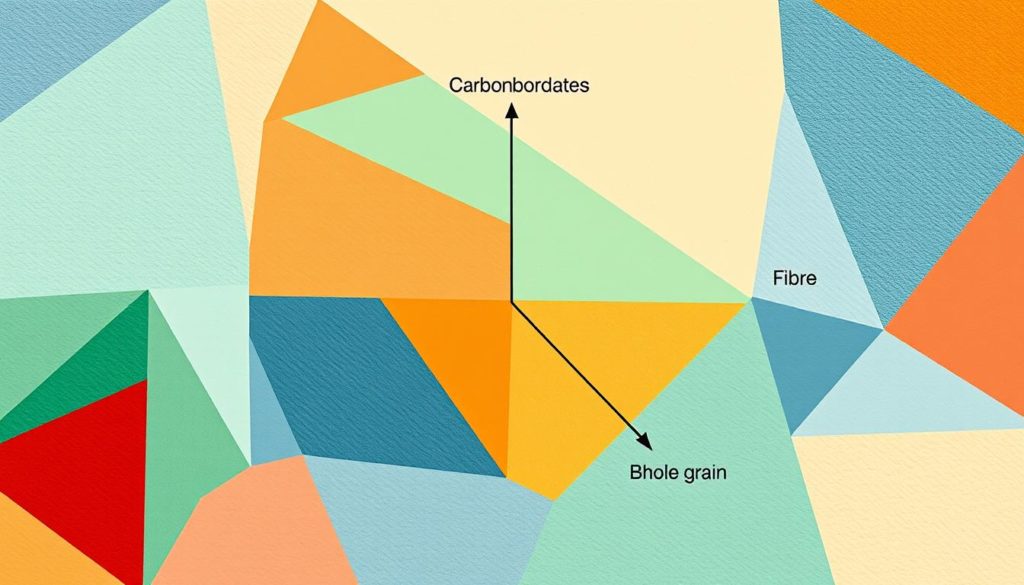Did you know nearly 34.2 million Americans have diabetes? Many don’t realize how important their diet is in managing this condition. Balancing carbs and fiber is key to controlling blood sugar, managing weight, and staying healthy.
Choosing the right carbs and enough fiber can greatly help with diabetes management. Fiber helps avoid blood sugar spikes. It’s crucial for controlling blood sugar, and it supports heart and digestive health too.
By eating high-fiber foods and the right carbs, you can manage your diabetes better. This also lowers your risk of heart disease and some cancers. Learn how to balance your diet for better diabetic health.
Understanding Carbohydrates and Blood Sugar
Understanding carbs is key to healthy blood sugar. They provide glucose, our main energy source.

The Role of Carbohydrates in the Body
Carbs are essential for our diet. They turn into glucose in digestion. This glucose gives our cells energy.
For people with diabetes, managing carbs helps control blood sugar.
Types of Carbohydrates
Knowing the types of carbs is vital. The three main types are:
- Starches: Found in foods like bread and pasta, they slowly release glucose.
- Sugars: Present in fruits and sweets, sugars quickly raise blood glucose.
- Fiber: It doesn’t break down, so it helps manage blood sugar and hunger.
Impact on Blood Glucose Levels
Carbs impact blood sugar differently. Starches and sugars cause quick rises that must be managed. Fiber, though, doesn’t affect it because our body doesn’t digest it. Learning about carb types helps in controlling blood sugar.
The Importance of Fiber for Diabetics
Fiber is crucial for those with diabetes. It helps control blood sugar and brings health benefits. This aids in managing the condition.
Health Benefits of Fiber
Fiber in a diabetic diet offers several benefits. It keeps blood sugar levels stable, lowers cholesterol, and helps with digestion. It also makes you feel full, which helps manage weight.
Types of Fiber: Soluble and Insoluble
There are two kinds of fiber, soluble and insoluble. Each has a special role in diabetes care and overall wellbeing.
- Soluble fiber: It controls blood sugar and cholesterol. This happens by forming a gel in the gut that slows digestion.
- Insoluble fiber: It improves gut health and insulin sensitivity. It does this by making stool bulkier, helping it move through the gut.

Recommended Fiber Intake
There are specific recommendations for fiber intake. Women should get 22 to 28 grams a day, and men should have 28 to 34 grams. Eating fruits, vegetables, whole grains, and legumes can help meet these goals.
| Gender | Recommended Daily Fiber Intake |
|---|---|
| Women | 22-28 grams |
| Men | 28-34 grams |
Carbs, Fiber and Diabetes
Managing diabetes means knowing how to handle carbs and diabetes together. Carbs affect your blood sugar a lot. However, you shouldn’t cut them out completely. Balancing them with dietary fiber helps control managing blood sugar better.
Dietary fiber is very important for those with diabetes. While carbs can spike your blood sugar, fiber slows down this spike. It’s important to know how fiber’s role in diabetes helps keep blood glucose steady.
Fiber, different from other carbs, doesn’t spike your blood glucose. It plays a big part in diabetes control.
To manage diabetes well, you need to balance carbs with dietary fiber. Let’s look at how they affect your body:
| Nutrient | Effect on Blood Sugar | Benefit |
|---|---|---|
| Carbohydrates | Increases Blood Sugar | Provides Energy |
| Dietary Fiber | Minimal Impact on Blood Sugar | Helps Regulate Blood Glucose Levels |
Adding the right amount of dietary fiber is key to a balanced diet. This helps keep managing blood sugar levels in check. It allows people with diabetes to live healthier. They can still enjoy different foods.
Low Carb Diet: Pros and Cons for Diabetics
A low carb diet for diabetics is becoming popular. It helps control blood sugar and manage weight. Both pros and cons exist, making it important to decide wisely.
Benefits of a Low Carb Diet
- Improved Blood Sugar Control: This diet is good for regulating blood sugar. It lowers the glucose spikes that trouble diabetics.
- Weight Management: It helps in losing weight. This can also boost insulin sensitivity.
- Reduced cravings: It helps steady hunger levels. Plus, it cuts down cravings for sweets, leading to healthier eating.
Potential Drawbacks
There are clear benefits, but one must also think about the downsides:
Not balancing the diet might lead to not getting enough vitamins and minerals.
- Some might feel bad at first, with symptoms like headaches or feeling tired or cranky.
- Sticking to this diet could be hard over time without many low carb choices.
Tips for Implementing a Low Carb Diet
Moving to a low carb diet takes careful planning:
Gradually reduce carbohydrate intake: This eases withdrawal symptoms, making the shift smoother.
Choose nutrient-dense, high-fiber carbs: Pick whole foods such as veggies, nuts, and seeds. They keep the diet healthy and full of nutrients.
| Category | Food Recommendations |
|---|---|
| Vegetables | Leafy greens, broccoli, bell peppers |
| Proteins | Lean meats, fish, eggs |
| Healthy Fats | Avocado, olive oil, nuts |
By following these tips, diabetics can enjoy the benefits of a low carb diet. It also helps in avoiding some drawbacks.
Choosing Fiber-Rich Foods
Adding fiber-rich foods to your diet helps manage diabetes. They balance blood sugar and supply key nutrients. We’ll discuss the value of eating healthy fruits and vegetables, whole grains, and legumes and nuts regularly.
Fruits and Vegetables
Fruits and veggies are great for fiber. Include lots like leafy greens, carrots, and broccoli for vitamins and fiber. For fruit, berries, apples, and pears are best. They have lots of fiber but little sugar, which helps keep blood sugar steady.
Whole Grains
Whole grains keep energy up all day. Go for brown rice, quinoa, and whole wheat bread. They’re packed with whole grains benefits. These carbs break down slowly, so blood sugar doesn’t spike. Whole grains make glycemic control better and energy last.
Legumes and Nuts
Legumes and nuts, like lentils, chickpeas, and almonds, are rich in protein and fiber. Using legumes and nuts for diabetes is smart. They offer lasting energy and keep you full. Plus, they’re low in bad fats and sugars, ideal for diabetic eating.
Managing Diabetes with Diet
Managing your diet is key to controlling diabetes. You can use several strategies to help balance your blood sugar through diet. One important step is to watch the type and amount of carbs you eat. Choose whole grains instead of processed carbs to help manage your blood sugar levels.
Adding high-fiber foods to your diet is also great. Fiber helps with digestion and helps keep your blood sugar stable. You can learn more about fiber’s role in managing diabetes and its benefits for health.
For better blood sugar control, try these diet tips:
- Monitor carbohydrate intake: Tracking your carb intake can help avoid blood sugar spikes.
- Incorporate non-starchy vegetables: Eat vegetables like broccoli, spinach, and bell peppers for key nutrients without a big sugar impact.
- Choose lean proteins: Foods like lean meats, fish, and legumes can balance blood sugar and keep you full.
High-fiber foods are important for managing diabetes. Adding foods like whole grains, legumes, and vegetables can really help. Start slowly with fiber to prevent digestive problems and make your diet change easier.
By using these dietary strategies, you can manage diabetes better and live a healthier life. These changes might take time and effort, but the health benefits are worth it.
Creating Diabetic-Friendly Meals
Creating meals for diabetics involves a careful mix of carbs and fiber. This balance helps control blood sugar levels, improving health for those with diabetes. Here, we’ll show you how to achieve this and offer meal ideas and recipes to try.
Balancing Carbohydrates and Fiber
To make diabetic-friendly meals, it’s important to find the right mix of carbs and fiber. Carbs affect your blood sugar directly. But adding high-fiber foods can slow sugar absorption. Including vegetables, whole grains, and beans in your diet is a great way to improve this balance.
Sample Meal Ideas
Looking for diabetic meal ideas? Here are some tasty options:
- Breakfast: Oatmeal with berries and flax seeds on top.
- Lunch: Quinoa salad with veggies, chickpeas, and lemon-tahini dressing.
- Dinner: Grilled chicken with steamed broccoli and brown rice.
Easy Recipes to Try
Need easy diabetic recipes? Check out these simple, nutritious picks:
- Vegetable Stir-fry:
- Sauté bell peppers, broccoli, and snap peas.
- Add tofu or chicken for protein.
- Flavor with low-sodium soy sauce and serve over brown rice.
- Hearty Lentil Soup:
- Mix lentils, tomatoes, carrots, and celery in a pot.
- Cook in vegetable broth until lentils are soft.
- Add your favorite herbs and pair with whole-grain bread.
Making diabetic-friendly meals is easier than you think. Keeping a good balance of carbs and fiber lets you enjoy tasty and healthy dishes. Try these meal ideas and recipes to discover what you like best.
High Fiber Diet for Diabetes Management
A high fiber diet plays a big role in managing diabetes. It helps in slowing sugar absorption in the body. This keeps blood sugar levels more stable over time. Eating foods high in dietary fiber has many health benefits important for diabetes.
Adding fiber-rich foods like fruits, vegetables, whole grains, and legumes is key. These foods make managing diabetes easier and more effective. Benefits include better control of blood sugars and even losing weight, which is essential for people with diabetes.
For those trying to improve their diet, check out these high-fiber options:
| Food Category | Examples | Fiber Content (per serving) |
|---|---|---|
| Fruits | Apples, Berries | 4-8 grams |
| Vegetables | Broccoli, Carrots | 3-5 grams |
| Whole Grains | Oats, Brown Rice | 4-6 grams |
| Legumes | Beans, Lentils | 6-8 grams |
Eating fiber-rich foods every day can help a lot with diabetes management. Knowing which foods are high in fiber can lead to better health for people with diabetes. Always talk to a doctor before making big diet changes. This ensures the changes are good for your health needs.
The Role of Fiber Supplements for Diabetes
Using fiber supplements can help when you don’t get enough from food. We’ll look at different fiber supplements, how to add them to your diet, and their pros and cons.
Types of Fiber Supplements
There are many fiber supplements on the market. It’s important to choose the right one for managing diabetes. Some common types are:
- Soluble fiber supplements (e.g., psyllium husk, guar gum)
- Insoluble fiber supplements (e.g., wheat dextrin)
- Functional fibers (e.g., inulin, polydextrose)
How to Incorporate Fiber Supplements
Adding fiber supplements to your diet needs a bit of know-how. Here’s some advice:
- Start with a small amount to avoid tummy issues.
- Slowly increase the amount to give your body time to adjust.
- You can mix them with water or put them in your food.
- Talk to a doctor to get the amount just right for you.
Potential Benefits and Risks
Fiber supplements can help control blood sugar, improve gut health, and help you feel full. But, there are risks too:
- They might cause bloating and gas.
- They can affect how your body absorbs some medicines.
- Using them wrong could mess up your nutrient balance.
When using fiber supplements, think about these things to get the most out of them while avoiding problems.
Meal Planning Strategies for Diabetics
Meal planning is key for diabetics to control blood sugar and stay healthy. It helps create balanced meals that meet nutritional needs without causing blood sugar spikes. Counting carbs is a major part of this. It helps track foods that affect blood glucose directly.
Eating lots of fiber-rich foods is also crucial. Vegetables, fruits, whole grains, and legumes are good choices. They slow sugar absorption and help manage blood sugar better. Fiber also helps you feel full, assisting in weight control. This is important for managing diabetes.
It’s vital to avoid foods high in sugar to keep meals balanced. Planning meals ahead helps skip unhealthy choices and stick to dietary goals. Using these strategies makes managing daily nutrition easier. It also promotes long-term health for those with diabetes.
FAQ
What are the main types of carbohydrates and how do they impact blood glucose levels?
Carbohydrates come in three types: starches, sugars, and fiber. Starches and sugars can raise blood glucose when they’re digested. Fiber doesn’t affect glucose since the body doesn’t break it down.
How does fiber benefit individuals with diabetes?
Fiber is great for people with diabetes because it helps control blood sugar. Soluble fiber manages blood sugar and cholesterol. Also, insoluble fiber boosts digestive health and insulin sensitivity.
What are the recommended daily fiber intake levels for adults?
Adults should get 22 to 34 grams of fiber every day. You can meet this goal by eating fruits, veggies, grains, legumes, and nuts.
Can a low carb diet help in managing diabetes?
Yes, cutting carbs can help manage diabetes. It helps with blood sugar and weight control. But, you need to reduce carbs slowly and eat a balanced diet to avoid missing out on nutrients.
What are some high-fiber foods that are good for diabetics?
Diabetics should eat high-fiber foods like fruits, veggies, grains, legumes, and nuts. These provide vitamins, minerals, and fiber, which help control blood sugar and improve health.
How can I create diabetic-friendly meals?
To make diabetic-friendly meals, balance carbs with fiber. Use ingredients like non-starchy veggies, lean proteins, and whole grains. This will keep your blood sugar in check. Planning meals this way can help manage diabetes better.
What are the potential benefits of including fiber supplements in a diabetic diet?
Fiber supplements can help diabetics control blood sugar when it’s hard to get enough fiber from food. They also support digestive health. But, add them slowly to your diet to prevent stomach issues.
Why is meal planning important for diabetics?
Meal planning is key for diabetics because it helps meet dietary goals. It ensures steady blood sugar levels by allowing control over carbs and focusing on high-fiber foods.


